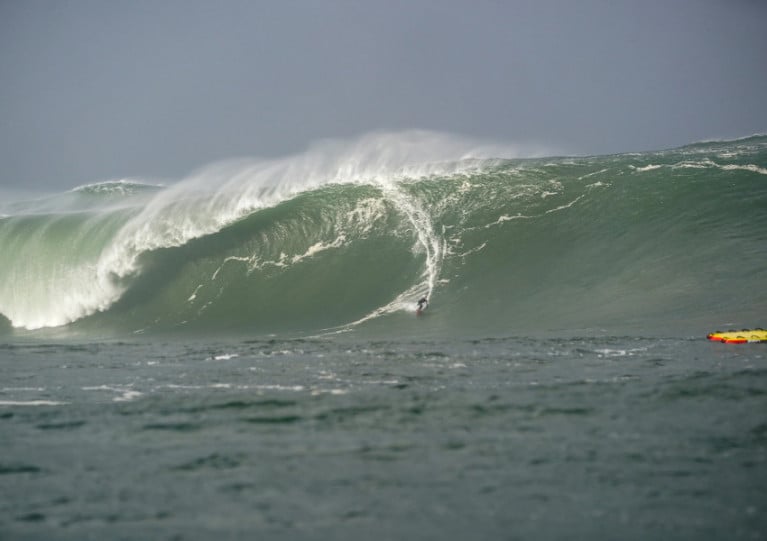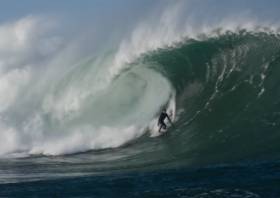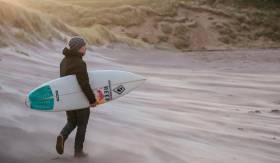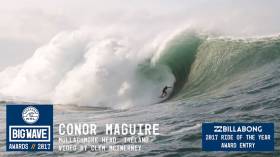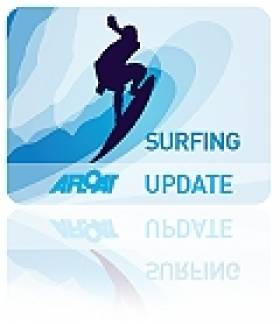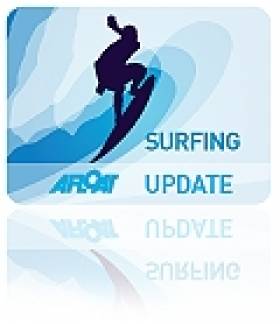Displaying items by tag: Conor Maguire
Big Wave Surfer Conor Maguire Takes on Mammoth Wall of Water Off Mullaghmore
Stormy weather means fuel for swelling seas off the surfing hot spot of Mullaghmore in Co Sligo.
And Irish big wave surfer Conor Maguire was there this week to catch the mammoth walls of water, as RTÉ News reports.
Three years ago, the Bundoran native made headlines for riding what’s believed to be the biggest wave ever recorded in Ireland’s waters at an estimated 60 feet.
This week he was first in line to make the most of the swell off the Sligo coast.
But for Red Bull team member Maguire, it was a mere warm-up for the bigger game at Nazaré in Portugal as the forecast shows the potential for record-breaking surf.
RTÉ News has video of Maguire’s incredible surfing feats HERE.
Conor Maguire Gets Nods in 2021 Red Bull Big Wave Awards for Surfing ‘Ireland’s Biggest Wave’
Irish surfing star Conor Maguire has been nominated for Ride of the Year in this year’s Red Bull Big Wave Awards, which recognise the most astounding big wave surfing feats the world over.
He’s also up for Biggest Tow for his breathtaking ride off Mullaghmore Head on 28 October 2020, as filmed by Clem McInerney — a 60-foot monster that’s believed to be the biggest wave ever surfed in Ireland, as previously reported on Afloat.ie.
And Conor’s also a nominee for Performer of the Year in a field with such fearless talent as Kai Lenny, who took on the fames Jaws in Hawaii; Grant Baker at the storied Mavericks break in California; and Sebastian Steudtner who took on the mammoth walls of water at Nazaré in Portugal.
A whopping $350,000 is up for grabs in the awards that “honour the athletes pushing the boundaries of what’s possible and celebrate the most death-defying surfing of the season”. The winners will be announced during the 2021 Red Bull Big Wave Awards Show on Friday 29 October.
Conor Maguire Rides ‘Ireland’s Biggest Wave’ at Mullaghmore Head
It was an opportunity too big to miss: the biggest waves ever seen at a spot already renowned for significant swells.
But big wave surfer Conor Maguire wasn’t taking any chances, making sure to consult with the proper authorities before heading out to ride what might be the biggest wave recorded at Mullaghmore Head.
As previously reported on Afloat.ie, the remnants of Hurricane Epsilon in the Atlantic brought ‘phenomenal’ class seas and waves up to 21 metres — more than double the typical height for the area — to the North West Coast earlier this week.
That would normally be a screaming alarm for surfers the world over to make the dash to Sligo, but continuing Covid-19 travel restrictions meant this time the ‘mutant’ surf was strictly for the locals.
And even at that, as the Guardian reports, veteran surfer Maguire needed to make sure he wasn’t stepping on any toes by heading out into the big blue on Wednesday 28 October.
He told surfing website Magic Seaweed: “We contacted Sligo County Council and got permission to surf, spoke to the coastguard.
“We had four skis and a paramedic on hand; two spotters on the cliff. We couldn’t have been any more safe, and [it was] the perfect time to take a good crack at it.”
Magic Seaweed has more in its exclusive interview with Conor Maguire, who also shared his story with Red Bull.
Irish Surfing Documentary Premieres In Bundoran This Saturday
#Surfing - If you’re in Bundoran this Saturday (22 September), you may be able to catch the world premiere of a new documentary on the legacy of Irish surfing.
Made In Ireland will screen at The Chasin’ Bull at 6pm and admission is free, but spaces are limited so seats must be reserved via Red Bull.
Mikey Corker’s film follows local big wave surfer Conor Maguire as he rides Ireland’s most renowned swells and meets the characters that help make this country’s surfing scene so sought-after.
Conor Maguire Now Surfing For Red Bull
#Surfing - Bundoran big wave surfer Conor Maguire has joined the Red Bull stable.
The 24-year-old was recently spotlighted during his preparations for La Vaca Gigantic in Spain, and is currently working on a documentary on surfing in Ireland.
See a clip from recent footage of Maguire in action among Ireland’s now world-renowned cold water waves below:
#Surfing - Irish sports website The42 has turned its spotlight on young Irish big wave rider Conor Maguire, who’s beginning to make a big impact abroad as he works on an upcoming three-part documentary on surfing in Ireland.
Currently prepping for La Vaca Gigante in Santander, Spain — with two more months to go in the waiting period for the right conditions to arise — Maguire tells The42 about his training regimen, much of which involves underwater exercises to emerge from those all-too-common wipeouts unscathed.
Something else that’s key to the 24-year-old’s routine, and may not be the first thing that comes to mind with such thrill-seeking extreme sports like big wave surfing, is yoga.
“[While] it helps with making your body limber, there are other benefits as well,” says the Bundoran resident. “It allows me to stay calm quite and, in general it’s definitely something all surfers could benefit from.”
The42.ie has much more on the story HERE.
Two Irish Surfers Up For 2017 Big Wave Prize
#Surfing - Two Irish surfers are nominated for ride of the year in the 2017 WSL Big Wave Awards after taking on the monster swell at Mullaghmore Head last month.
Conor Maguire and Peter Conroy were in the right place at the right time on 9 February to get a tow-in to the ‘emerald walls’ at the surfing hotspot off Co Sligo.
Bundoran resident Maguire found himself barrelled by the kind of surf usually associated with the big wave paradises of the Pacific.
Meanwhile, Northcore team member Conroy, from Co Clare, caught his own massive wall of water to stake his claim among the world’s top riders.
Both clips were captured by Clem McInerney, who was also on hand to shoot one of American surfer Will Skudin’s two nominated efforts at Mullaghmore — as well as Dublin-based Emirati surfer Mo Hassa Rahma’s spectacular wipeout, as The National reports.
Video: West Coast is Winter Hotspot for Surf Pros
#SURFING - Conor Conlon of CMP has produced this wonderful video of top professional surfers taking on the Atlantic swells of the west coast this winter.
Setting up his gear on the shore during a window of clean swell, Conlon captured the likes of Aaron Dees, Conor Maguire, Easkey Britton and newly signed Ripcurl rider Noah Cohen catching the waves (more photos and video HERE).
Young Bundoran Surfer Joins Northcore Stable
#SURFING - Irish surfer Conor Maguire is one of the four new waveriders from the UK and Ireland to become part of the Northcore stable. In the vid below Maguire is mentioned at 2 minutes 11 seconds.
The Bundoran resident joins Sandy Kerr of Tynemouth, England, Craig Burrows of south Wales and Jersey's Charlotte Bayliss on the team heading into 2012.
The young surfer is already making a name for himself on the heavy waves of Ireland's northwest coast like the Peak, and regularly paddling into the meanest of Ireland's slabs such as Rileys.
Maguire is also starting to charge in the big swells, learning the tow-in craft from some of Ireland's most experienced big wave crews, including Northcore ambassador Richie Fitzgerald.
A Northcore spokesperson said of the recent additions: "Between them there's a huge amount of experience, style and skill. All of the riders are representing the very best of surfing talent from their respective home locations and all have achieved respect and recognition on a national scale."


























